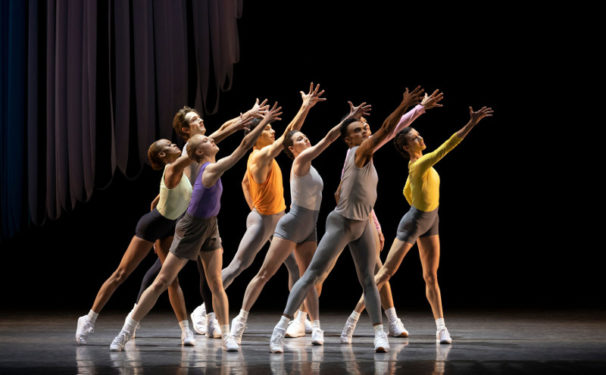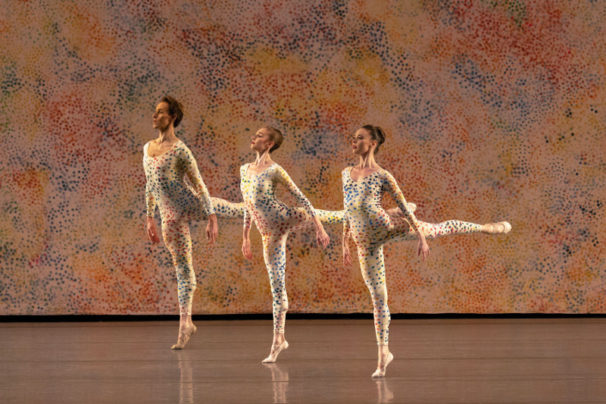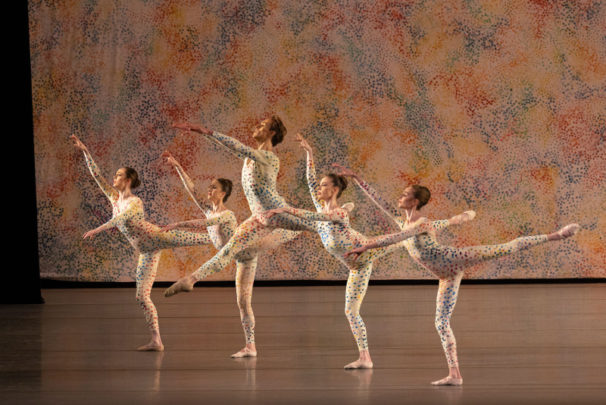
christopher wheeldon’s DGV: danse à grande vitesse
Scenery! Intermissions! One takes these for granted – or used to. But experiencing them as part of New York City Ballet‘s opening night marked another step toward normalcy, after the company’s fall repertory season consisted of intermissionless programs featuring ballets that require no time-consuming scenic installations. Fortunately, NYCB’s repertory includes an abundance of works in which brilliant choreography works its magic on an unadorned stage.
But the winter season opened with “New Combinations,” a program of three ballets that all feature an integral, essential scenic element. After a nine-day delay in starting up, due the effects of the Omicrom surge (which had also caused NYCB to lose the final two weeks of Nutcracker performances), the presence of such color and texture on stage enhanced the celebratory mood.

The main event was Partita, the latest work by Justin Peck, NYCB’s versatile and ingenious resident choreographer. Peck chose Caroline Shaw’s 2013 Pulitzer Prize-winning Partita for Eight Voices, a densely textured a cappella score that fluidly slips from counting and chanted words to unusual choral sounds that evoke shape-note singing or ancient vocal traditions. Joining the collaboration is artist Eva LeWitt, whose colorful hanging panels of what look like giant looped fringes of fabric offered a pastel rainbow and sculpted the stage space without interfering with the dancing.
Taking his cue from the score, Peck worked with eight dancers, and LeWitt created eight of her hanging fringed curtains, ranging considerably in size. Wearing simple, sporty costumes (the women in shorts, the men in tights, with pastel tank tops in muted pastels for all), the eight dancers evoked Robbins-like adolescents at play, gamboling in the sunshine. Peck made them feel like a group of deeply in-tune friends as they glided and swiveled in their sneakers.

Peck and Shaw have collaborated twice at the Vail Dance Festival on projects for which she wrote original scores. So he knows and understands her work well, and she in turn has been a generous collaborator to other choreographers. Peck has said he was captivated by this score for years, but only now found it the right moment to choreograph it.
Even with a small cast, Peck’s gift for animating clusters and ensembles of dancers is the focus here; one feels an organic pull between the dancers in the opening section. It starts wittily; Shaw’s score enunciates such phrases as “to the side,” “and around” and momentarily the dancers embody those concepts. But with the vocalists’ quick shift into haunting wordless harmonizing, the dancers are set on their own course that complements rather than illustrates their sounds.
Peck sends them through casual, exploratory phrases that they shape and unfurl with playful spontaneity. There’s a refreshing, invigorating, unfussy energy here. Clarity and directness dominate, enhanced by LeWitt’s visual accompaniment, which resonates with airiness and calm.
In the second and third movements, Peck juxtaposes a female duet, for India Bradley and Claire Kretschmar, followed by a male duet for Harrison Coll and Taylor Stanley. The women are quietly meditative, moving with an interior energy. The men are carefree and daring, as if taking advantage of the open air. Tiler Peck leads the way in the concluding fourth movement; she’s a quiet whirlwind pivoting and slicing with her trademark bold energy while also appearing to inhabit her own private thoughts. Chun Wai Chan partners her for a while, before she continues on her own until the full cast gradually assembles into engaging new fluid formations as the stage energy expands and contracts.
Partita is a gentle work that insinuates itself subtly across the footlights. This cluster of supportive companions seems to inhabit fresh air and a hopeful place. They explore and investigate, stretching and twisting and moving with unforced, casual elegance. The fascinating score was expertly performed by the superb eight-member vocal ensemble, Roomful of Teeth (which includes Shaw) and for whom the piece was composed.

Partita shared the program with Merce Cunningham‘s eloquently luminous Summerspace, the 1958 work he adapted for NYCB dancers in 1966. A quiet evocation of natural beauty, its return to the repertory is always most welcome, though not all the dancers were ready to relax into Cunningham’s movement that requires a pliant spine along with classical precision. Adrian Danchig-Waring and Ashley Laracey had lovely moments.

Christopher Wheeldon‘s turbo-charged DGV: Danse a Grand Vitesse, with its large curving set pieces that seem to condense the stage space harshly, is an efficient four-movement machine that allows four couples to engage in sleek, sometimes acrobatic partnering. There are magical moments when the large ensemble seems to materialize and collect out of nowhere, accumulating surging power. But the chugging sameness of Michael Nyman’s score leads to diminishing returns, and the would-be crescendo of energy gives way to numbness. DGV serves the purpose as a large-cast program closer, but It was a letdown at the end of such an otherwise bracing program. One looks forward to deeper acquaintance with Peck’s Partita; it’s clearly a keeper.
Photos: Erin Baiano for New York City Ballet
New York City Ballet, January 27, 2022
“New Combinations” program: Partita, Summerspace, DGV: Danse a Grand Vitesse
Susan Reiter covers dance for TDF Stages and contributes regularly to the Los Angeles Times, Playbill, Dance Australia and other publications.
